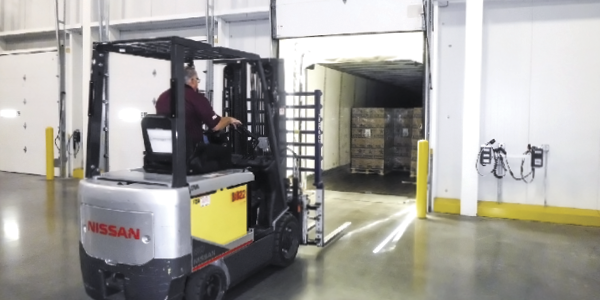
We’re All in This Together: Teamwork in a Lean Workplace
While some Lean practitioners focus on manufacturing pioneer Taiichi Ohno’s Seven Wastes (transportation, inventory, motion, waiting, overproduction, overprocessing, and defects), many add an eighth waste: behavioral waste, or under-utilized employees. It takes a real change management effort to successfully implement a Lean program—especially when it involves changing workers’ habits. Someone who has been doing a […]

When Government Oversight of Motor Carriers Fails, Shippers Pay
While overall truck accident rates have been trending lower over the past several years, avoidable carrier accidents are still common. Comprehensive safety compliance reviews (CRs) by the U.S. Department of Transportation’s Federal Motor Carrier Safety Administration (FMCSA) protect lives and property. In the year after a CR is conducted, crashes decrease 16.3 percent, according to […]

Consumer Electronics and Reverse Logistics: Play It Again
Shoppers return between 11 and 20 percent of consumer electronics devices, according to industry experts. While returns are the beginning to device recovery, all the steps in the reverse logistics process, including repair/refurbishment and remarketing, can be improved. Recognizing the importance of reverse logistics in maintaining and growing profit margins, many consumer electronics manufacturers and […]

Keeping Track of Time
If your average day is anything like mine, you face an endless barrage of internal emails, corporate memos, newsletters, and once-in-a-lifetime opportunities to refinance a home loan. Spam filters, email notifications, and custom preferences help organize this self-perpetuating info soup, making it easier to manage communications—then act according to priority. Complicating matters is the reality […]
Selecting the Right Drayage Provider
Drayage—moving shipments short distances, such as from a port to a nearby warehouse—plays a critical role in intermodal moves, and selecting the right motor carrier partner goes well beyond the lowest rate. Once you move past monetary considerations, examine the total service offering to ensure your drayage provider is the perfect fit. James Miller, account […]

Hu Huang: Bright Light in Global Trade
Hu Huang is director of international logistics and customs compliance at Kichler Lighting in Cleveland, which is among the top one percent of importers in the United States. She has worked for Kichler since 1988, and served in her current position since 2002. Responsibilities: Worldwide imports and exports, including direct imports to Fortune 100 companies; […]

Trends—August 2013
The Government is ‘Helping’ Again… Transportation and logistics companies have a hard enough time navigating the twists and turns in today’s economic landscape without facing inertia from the executive branch. But states are strapped for cash, and lawmakers are trapped by special interests. Many are acting on impulse, then ducking for cover. The Minnesota State […]

Global Logistics—August 2013
America’s Global Image: Taking a Closer View Yahoo! News paints a pretty grim picture of how outsiders perceive the United States: "Who loves ya, baby? If you’re the United States of America, the answer is fewer and fewer people around the world," according to a recent blog by the online news aggregator. Yahoo! might consider […]

Feeding the Line
When you make materials or components for other companies, their production rhythms become just as important as your own.

Get Airborne with Asset Tracking
In today’s complex global supply chain, transportation delays, security issues, and spoiled or lost cargo too often disrupt the distribution process. In air transportation, cargo often travels via multiple airports, airlines, ground handlers, and across geographies, creating ample opportunity for problems to occur. While other transport modes have had the benefits of GPS technology to […]

New Transatlantic Trade Pact Could Be Favorable “TTIP-ing” Point for Logistics Sector
In announcing the start of negotiations to forge a new trade agreement between the United States and the 27-nation European Union (EU), British Prime Minister David Cameron said at the G-8 summit meeting held in Northern Ireland in June 2013 that there is "no better way to drive growth and prosperity around the world" than […]

Have You Seen That 584-Page ‘Map’ Yet?
If you are reading this magazine, you are likely either directly or indirectly involved in the $700 billion domestic freight industry. So you know that to be successful, every logistics organization must overcome hurdles that challenge profitability, on-time service and, most importantly, safety. One of these hurdles should not be a marketplace that tolerates carriers, […]
Cintron Quenches Thirst For Order Management System
A Web-based OMS provides a shot of energy to Cintron’s inventory and order management processes.

Lift Trucks on the Rise
Ready to invest in new and upgraded lift trucks to boost warehouse efficiency? Consider these three trends before making your move.

Inbound Logistics’ Summer Reading Guide 2013
Hitting the beach this summer? Don’t forget to bring something to read. Whether you need just a little brushing up, or are looking for the latest best practices to streamline your supply chain, sharpen your logistics skills with these books covering everything from Lean practices to information technology.

Cross-border Trade Secrets
When moving shipments into and out of Canada, what you don’t know can hurt you. Specialized logistics providers can help you capitalize on opportunities, ensure compliance, and keep you safe from harm.

Using Big Data to Build Tomorrow’s Supply Chain Today
Q: How can transportation and logistics companies use big data to differentiate themselves? A: Supply chain professionals in all industries and government sectors must transform their supply chain process to meet organizational strategies and goals. Information fusion breaks down the barriers spanning all demand-supply enterprises. A critical requirement is real-time, high-quality, reliable data and information […]

The Case for Transportation Management Software
Q: What innovative technology initiatives help increase supply chain efficiencies? A: The number one return on investment (ROI) that will provide continuous process improvement, and at the same time keep freight costs under control, is integrating a transportation management system (TMS) with a shipper’s existing systems, such as an ERP solution, warehouse or order management […]

Meeting the Challenges of the Ever-Evolving Compliance Environment
Q: Even though developing markets are growing rapidly, many companies are reluctant to expand operations overseas because they do not have relationships there, are unsure of the infrastructure, or are not familiar with local demands and requirements. What options are open to them? A: Looking for the right place to expand overseas is more important […]

Making a Business Case for GTM
Q: What is the role of global trade management (GTM) in organizations today? A: In today’s world, GTM is more than compliance. GTM practitioners should think of GTM as standing on three equal pillars: compliance, supply chain finance, and global logistics. A holistic approach is necessary given the growing complexity—both in regulations and geography—of international […]

Collaborative Freight Strategies Offer Lower-Cost Alternative to LTL
Q: Why is it important for small and mid-sized consumer packaged goods (CPG) shippers to collaborate on freight strategies to remain competitive? A: If they don’t, they will continue to pay more than their larger competitors, who have the volume to ship more economical full truckloads. For years, smaller shippers have accepted the higher cost […]

Trading Partner Collaboration Yields Supply Chain Value
Q: How can value chain partners collaborate to create and share efficiencies? A: Retailers and manufacturers have made progress in improving the effectiveness and efficiency of their individual supply chains. They have found savings and efficiencies, and implemented new processes. Now, trading partners must collaborate to find new avenues for improvement. The competitive retail landscape […]

Intermodal Transportation’s Strategic Advantage
Q: Why are shippers making intermodal more integral to their logistics strategies? A: Shippers are using intermodal for a variety of reasons. In many rail corridors, intermodal provides a much better value proposition than highway. Rail transportation is often more energy efficient, so “going green” in intermodal means moving freight costs less. With the driver […]

TMS or 3PL: Which Suits Your Business Best?
Q: How does implementing a transportation management system (TMS) compare to engaging a third-party logistics (3PL) service provider? A: A TMS provider’s core business is offering software solutions that solve customer transportation requirements. Companies that implement TMS solutions are looking for certain capabilities: maintaining relationships with carriers; improving supply chain management and effectiveness; streamlining operations; […]

Aerodynamic Trailer Add-ons Make Fuel Savings a Breeze
High transportation costs were a drag for Anderson Hay & Grain, until it installed aerodynamic trailer side skirts to increase fuel efficiency.

Bringing Supply Chain Visibility to the Last Frontier
A Web-based shipping tool helps Classic Alaska Trading Company tame the wilds of its inventory and fulfillment operations.

Business Process Improvement? Flexibility.
In his futile search for the Fountain of Youth, Ponce de León walked right past untold riches. If you are not evaluating your third-party logistics providers for their ability to drive strategic improvements in your enterprise, you may be doing the same thing. Thirty-three percent of respondents to our annual 3PL Perspectives market research survey […]

Finding Supply Chain Feng Shui
Business process improvement is especially important in today’s economic climate. Businesses are sensitive to fixed costs when the economy is swinging like a pendulum. There’s shared recognition that they have to stick to their principal business to grow out of the recession; and logistics execution and supply chain excellence is too important to ignore. That’s […]
Choosing the Right Airfreight Forwarder
In a global supply chain, timing and visibility are critical. So is selecting the best freight forwarder. Vito Losurdo, vice president of global airfreight services at UPS, offers the following advice for picking the best airfreight forwarder for your business. 1. Look for a broad portfolio. Partner with an established forwarder that provides a comprehensive […]

Matthew Wood: Finding a Cure for High Freight Costs
Matthew Wood is manager of the freight program, supply chain management, at Mayo Clinic in Rochester, Minn. He has held this position since 2012. Responsibilities: Managing freight expenditures for all items purchased by organizations within Mayo Clinic; helping departments find ways to reduce their freight costs; marketing those services to other healthcare organizations. Experience: More […]

Extended LEAN™ Increases Speed to Competitive Advantage. Continuous Improvement Method Takes Companies from Surviving to Thriving
Most operations and logistics leaders have spent at least part of their careers implementing LEAN principles within companies to improve quality, cost and delivery performance. The majority likely learned basic LEAN methods in week-long doses of kaizen ("good change" in Japanese) events trying to reduce wastes. Today many of those early adopters—and new LEAN thinkers […]

Trends—July 2013
The 24th Annual State of Logistics Report: ‘Business Unusual’ Defines New Normal A long and winding path toward recovery has arrived at a seminal question: "Is this the new normal?" That was the topic and title of the annual State of Logistics presentation at the National Press Club in Washington, D.C., in June 2013. That […]

Global Logistics—July 2013
Brazilian Shippers Safer by Sea Poor road infrastructure and rampant larceny are forcing some Brazilian shippers to consider unconventional transport options. Case in point: Paranapanema, the country’s largest refined copper producer, has shifted domestic shipments from trucks to slow-moving ocean freighters, according to Bloomberg Businessweek. Although the mode shift nearly triples transport times, it cuts […]

Mobility Solutions That Improve Field Productivity
The freight and logistics industry is truly a mobile world. People, products, and packages are constantly on the move from one location to another, and employees are increasingly using smartphones in their daily lives—with all the benefits of continuous, high-bandwidth connectivity, stronger device capabilities, and more targeted applications. So how can the industry take advantage […]

3PLs Can Provide Soft Cost Savings for Small Businesses
Shipping is the second-largest cost many small businesses incur, after labor. Despite the challenges they face—including high gas prices, advancing technologies, and competitive markets—small companies must continue to move products from Point A to Point B. To keep productivity high and customers happy, some small businesses seek ways to cut shipping costs, including engaging third-party […]

Preparation: Your Best Asset in Managing Supply Chain Disruptions
Supply disruptions occur daily, caused by delayed deliveries; weather impacts on inbound supply; and prolonged standstills associated with natural disasters, port labor strikes, or critical supplier failures. Whatever the reason for the disruption, supply chain managers prove their value by delivering—no matter the circumstances. An active risk management process helps identify a range of possible […]

Improving America’s Ports: A Vital Step in U.S. Economic Recovery
In its March 2013 Report Card for America’s Infrastructure, the American Society of Civil Engineers (ASCE) included port infrastructure for the first time in its comprehensive infrastructure analysis. ASCE’s reports are instrumental in showing the need for infrastructure investment, and the economic impact of its neglect. Advocating for increased federal investment in seaport-related infrastructure—including both […]

Adopting Online Training To Enrich Your Workforce
The popularity of online training is skyrocketing. Many companies are discovering the benefits of using online training to help supply chain employees boost their knowledge and add cross-functional value to the organization. The advantages of online training include: Reducing the travel and tuition costs associated with training. Training more employees at less cost. Reinforcing alignment […]

10 Trends Driving Greener Supply Chains
Many businesses today are seeking smart ways to reduce supply chain waste and carbon impact. Over the next several years, the following trends could transform logistics operations, particularly in emerging markets. 1. Creative, collaborative planning. Logistics providers and shippers can find simple ways to better manage schedule requirements, such as building slow-steaming into overseas shipment […]

C-TPAT: Building Safer Supply Chains
The growing security concerns companies face in the global market make it critical to understand potential supply chain risks, and establish a managed, proactive approach to security. One significant step companies can take to protect their supply chains is becoming a member of the Customs Trade Partnership Against Terrorism (C-TPAT) program. As C-TPAT members, organizations […]

Hiring Heroes: A Good Deal for U.S. Companies
The logistics sector is waging war against high unemployment among veterans with aggressive hiring programs that benefit both sides.

Middle East/North Africa: MENA at Work
As Middle East and North Africa (MENA) countries pursue political transformation and economic diversification, transportation and logistics investment is the cornerstone to future growth.

Supply Chain Remodeling
When supply chains need a fresh look, 3PLs can draft a blueprint for renovation.
2013 3PL Perspectives: Drafting a Blueprint for Growth
Inbound Logistics’ ninth-annual 3PL Perspectives market research report documents how 3PLs are differentiating their value proposition beyond transactional services—creating an outsourcing blueprint for shippers to grow, in spite of economic uncertainties.
Readers’ Choice: Top 10 3PL Excellence Awards 2013
MORE TO THE STORY: About the Survey Respondents Built to Last: A Sampling of Reader Comments 3PLs to Watch Supply chain challenges can weaken a business’ foundation, clogging product flow, wearing away at customer satisfaction, and draining profits. Whether companies need a minor supply chain touch-up or a major overhaul, enlisting a knowledgeable third-party logistics […]

Transportation Infrastructure: Building Hope for the Future
As U.S. industry confronts the realities of a failing transportation system and looming capacity crunch, does MAP-21 offer the promise of improvement?

Discount Apparel Logistics: Outfitting the Outlets
As consumers embrace bargain hunting, off-price apparel retailers re-style their supply chains to meet demand.

Polishing the Furniture Supply Chain
Faced with mounting logistics challenges, U.S. furniture manufacturers let specialized carriers and white-glove delivery experts handle the heavy lifting.

Guiding an Energy Renaissance: Questions and Answers With Michael O’Neill
The emergence of domestically sourced natural gas heralds significant changes in the North American energy market—especially in the way suppliers and producers move product.

Temperature-controlled Logistics: Cool Under Pressure
As demand for perishable products grows worldwide, efficient and effective cold chain management requires strong partnerships and quick reactions.

Global Logistics—June 2013
ASEAN Countries Attracting Attention As Europe’s economy copes with a sweeping debt crisis, and its Asian trade partners absorb the impact of declining exports and rising inflation, Southeast Asia is quickly becoming a center of attention—and transportation and logistics investment. Malaysia, for example, is looking to become a key transportation and logistics hub for the […]

Transportation Payment—Bank on a Better Way
The definition of "carrier" is pretty straightforward: an entity that transports freight. Carriers are in the transportation business, plain and simple. Actually, not so simple. Carriers are also in the credit business. Unintentionally, to be sure, but they are. When carriers set payment terms of 45 days, they are essentially extending credit to the shipper […]

Natural Gas For Long-Haul Trucking: Working Together to Get It Right
Q: The trucking industry is poised to increase its use of natural gas for heavy-duty, long-haul freight. Is this a good idea? A: Natural gas sounds like a dream proposition. It’s cheap, domestic, and, when it burns, it emits a quarter of the carbon dioxide (CO2) of diesel fuel—and few other pollutants. So it potentially […]

Reducing Defects and Errors: Don’t Make the Same Mistake Twice
One popular definition of insanity is "doing the same thing over and over again, and expecting different results." So why does that occur all the time in business? Whether it involves producing many items with the same defects, or continuous incorrect inventory counts, we keep shooting ourselves in the foot. Although 85 percent of quality […]

Sensor-based Logistics: Monitoring Shipment Vital Signs in Real Time
The global supply chain’s rapid growth is encouraging companies to look for new ways to improve efficiency, cut waste, and enhance supply chain dependability to deliver a superior customer experience. One tool for accomplishing these goals is sensor-based logistics (SBL). SBL provides full visibility inside shipments while they’re in motion, helping to ensure they reach […]

Logistics Staffing: Find a Way or Make One
The saying "find a way or make one" has always appealed to me because it prioritizes the need to first look for existing solutions before coming up with new ones. There is always a solution, and giving up is not an option. Why, then, do so many companies look outside for new logistics hires rather […]

The Lean Supply Chain: Watch Your Waste Line
Lean logistics can help your company shed fat and build muscle.

Getting Green, Going Lean
Creating a viable and sustainable green strategy can be a challenge for companies that want to be good corporate citizens, but also remain competitive. If customers are focused on price, how conscious is your green conscience when you need to drive out costs—at all costs? It’s a valid question in today’s economy as companies deliberate […]
Optimizing Warehouse Operations
Warehouse operations efficiency is key to the success of any company that processes, inventories, and ships orders. When efficiency lags, products may not arrive at customer destinations on time, orders can get lost, and low inventory levels can result in stockouts. Here’s some advice on optimizing warehouse operations from Chris Castaldi, manager of business development […]

Dino Lanno: Best in Glass
Dino Lanno has been senior vice president, supply chain at Safelite AutoGlass in Columbus, Ohio, since 2007. Responsibilities: Procurement, transportation, distribution, manufacturing, inventory management, and wholesale sales. Experience: Facilities engineer, WearEver Aluminum; product development engineer, Hamilton Beach Procter Silex; engineer manager, plant manager, WearEver Aluminum; regional warehouse manager, director of materials management, vice president of […]

Trends—June 2013
Is American-Made on the Mend? Rumors abound that U.S. manufacturing is making a comeback. The promise of cheaper domestic energy sources—and rising labor costs elsewhere around the world—are tipping the total landed cost balance off its Far Eastern axis. Does this portend a domestic manufacturing renaissance? A recent report by AlixPartners suggests companies are open […]

The Natural Gas Factor: New Market for Providers, New Competition for Capacity
The boom in natural gas and shale exploration in North America holds both good news and bad news for chemical companies. The natural gas being extracted from shale plays across the United States and in Canada has emerged as a low-cost alternative source for powering industrial facilities. As a result, some chemical manufacturers are reshoring […]

Logistics Education: Ready for the World
With a focus on international operations, logistics students and professionals prepare to manage complex global supply chains.

Delivery Scheduling Relieves Loading Dock Bottlenecks
An online appointment scheduling system gave beer distributor Crescent Crown control over trucks pouring into its distribution center.

Green Logistics The Walmart Way
Why sustainability best practices are part of the retailer’s supply chain DNA.

G75: 75 Green Supply Chain Partners 2013
The supply chain has been on the greening edge of innovation by nature of the business. Doing more with less to reduce waste in time, material, and cost is inherently green. Although it can be difficult to determine green ROI, many companies, industries, and governments have made great strides pushing the sustainability envelope in regulations, […]

Latin American Logistics: Keeping Up With the Latin Beat
The region’s improving infrastructure and trade policies offer companies supply chain expansion opportunities

Complex Products, Complex Logistics Needs
By their very nature, chemicals make for complicated logistics. Transporting, storing, and distributing flammable, corrosive, highly reactive and carcinogenic materials is not an easy task. And when things go wrong, it’s not just a late or missing shipment at hand—there are economic, environmental, and emotional consequences. The deadly fertilizer plant explosion that occurred in April […]

No Shortage of Challenges
Lack of capacity is one of the biggest challenges chemical shippers are currently grappling with. The culprits? The ongoing truck driver shortage, and changes to the Hours of Service rules, which take effect in July 2013 and will limit drivers’ time on the roads. While capacity issues are impacting all shippers, chemical companies feel the […]

Outsourcing for Optimum Supply Chain Effectiveness
MORE TO THE STORY: An Industry in Flux The chemical industry’s complex logistics needs, safety and security concerns, and regulatory issues make outsourced logistics, transportation, distribution, and warehouse services an important part of its supply chain. Third-party logistics (3PL) providers working with the chemical industry offer a wide range of services in different levels of […]

Supply Chain Technology Taps into Efficiencies
Access to technology is an important driver for logistics and transportation outsourcing in the chemical market. The industry has lagged behind some other verticals in adopting logistics and supply chain technologies, partly because of the business’ unique nature. Many small, specialized transportation providers serving the industry haven’t had the resources to offer electronic transaction services, […]

We Need Jobs…Let’s Raise Taxes?
Balancing a budget is an exercise in best judgment. Add politics to the equation, and logic flies right out the window. One example: the Minnesota legislature is finalizing its $38-billion state budget, which includes a 6.5-percent sales tax on warehouse services. A wide-ranging tax hike on warehouses will have far-reaching implications. None good. A warehouse […]

Inventory Optimization: A Natural Fit
A new inventory management system nurses Nature’s Best’s fulfillment operations back to health.

Site Selection: The Rise of Intermodal
Intermodal plays an essential role in today’s site selection process. Superior rail intermodal sites and services put your company on the right track.

Pallet Strategies: Stacking the Odds in Your Favor
When it comes to choosing the best pallet for your shipments, the smart money is on a strategic approach that anticipates future needs.

Inbound Freight Management: 5 Roadblocks (and How to Get Around Them)
Managing inbound freight effectively can be challenging, but the obstacles don’t have to deter you from the benefits. Our experts map out detours to help you reach your goal.

DC Automation: Sorting It Out
Changing consumer expectations and demand for greater efficiency, economy, and productivity present new twists and turns in warehouse automation.

E-Fulfillment Strategies That Deliver the Goods
By adding speed and visibility to their logistics operations, retailers delight online customers, and keep them coming back for more.

Why Mid-market Shippers Should Leverage TMS
Q: Mid-sized firms are often stretched for resources. How can they better manage transportation? A: Many mid-market shippers manage transportation "by avoidance." They know they could be doing it better, but don’t have the time or resources to focus on it. There’s always a fire somewhere, and if product is getting out the door and […]

Shoring up Sourcing Strategies
Q: What factors are driving reshoring/near-sourcing consideration? A: A balance in labor rates between China and North America is warranting a second look at sourcing and manufacturing closer to demand. Mexico may be a first choice because of its labor cost differential, but the United States, with the promise of cheaper energy, presents another opportunity. […]

What Happens When Your Warehouse Is Unplugged?
In warehouses, business as usual relies on steady and stable conditions—but these are not guaranteed. Numerous situations can disrupt productivity: A hurricane or ice storm comes through and knocks the power out for several days. You outgrow your warehouse and have to shut down while you move to a larger facility. The server finally crashes, […]

Northeast Florida: America’s Logistics Center Drives Global Business
Thanks to its strong transportation infrastructure system, the Northeast Florida region is on a solid trajectory for increased international trade, as well as logistics and supply chain management investments and employment. Dubbed "America’s Logistics Center," Northeast Florida is one of the only centrally located East Coast regions offering all four pillars of logistics: rail, air, […]

8 Ways to Strengthen Online Retailer Supply Chains
Most online retailers are well aware that effective supply chain execution is the strategic heart of their business. Here are eight ways to keep online retail supply chains running smoothly and cost-effectively. 1. Invest in people. Make sure your supply chain managers have adequate experience and knowledge. The right skill set can’t be learned on […]

Trends—May 2013
Garden State Gets Greener New Jersey and sustainable development are perfect together. Industrial real estate developer Prologis recently broke ground on a new, 880,000-square-foot distribution facility on the Hackensack River in Jersey City, N.J. The Prologis Pulaski Distribution Center, a 50-acre former landfill, is located four miles from the Port of Elizabeth and three miles […]

Global Logistics—May 2013
Did Hong Kong Strike Out? While Hong Kong’s season of labor discontent may augur an unsettling trend as Asia’s middle class continues to grow—along with discord concerning workers’ rights and compensation—the near-term implications serve as yet another reminder of the daily vagaries threatening supply chains. A lingering, month-long dockworker strike (as of press time) over […]
Larry Montreuil: True Blue
Larry Montreuil has been director of supply chain management at JetBlue Airways in New York since 2003. Responsibilities: Strategic sourcing, contracts and purchasing. Experience: Supervisor, materials management, New York Air; manager, logistical planning and provisioning, Continental Airlines; director of purchasing, Trump Shuttle; director of purchasing, Queens Surface Corp. Education: B.S., aeronautical industrial technology, Arizona State […]
Assessing Your Provider’s Financial Stability
There’s nothing worse than hiring a logistics provider or carrier, then having it file for bankruptcy or close shop the day before you have a huge shipment planned for a new customer. Danny Monson, president and CFO of States Logistics Services Inc., offers these tips for verifying a service provider is financially stable—before you start […]

Bringing Risk Management into the Heart of the Supply Chain
When supply chain executives are asked about the amount of contact they typically have with their chief risk officer, the answer is typically, "Not much." And they might add that their interaction usually involves providing input into enterprise risk management (ERM) for an update to their board. When asked whether the ERM team plays an […]

Delivering Procure-To-Pay Success
The next step in inbound logistics goes beyond delivering goods. As e-invoicing and procure-to-pay networks have evolved into broad-based business networks, advancements now enable professionals to finally connect all the dots in the supply chain. Over a secure cloud-based network, customers share accurate, actionable data with suppliers around the world, enabling immediate electronic transactions and […]

Business Intelligence in the Supply Chain
Thanks to business intelligence tools, companies are no longer awash in reams of data that they don’t know what to do with. Instead, logistics managers are using BI technologies to find real meaning in their sea of numbers—and take actions that boost supply chain efficiency and effectiveness.

Connect and Collaborate to Better Manage Freight Spend
Q: What are the current challenges of managing freight spend? A: In today’s slow-growth economic environment, organizations are pressured to reduce costs and manage inventory well. The result is demand for frequent deliveries, which amplifies the need to control shipment costs, according to research by the Aberdeen Group. In addition, organizations operate increasingly complex supply […]

Truckers and Shippers Prepare to Meet Over-the-Road Challenges
Q: What challenges do domestic transportation service providers face today as a critical part of the value chain for manufacturers and retailers? A: One of the most competitive segments of the trucking market, truckload (TL) companies also represent the core business of most asset-based, but diversified, transportation companies. Their most common concern, according to a […]

Transportation Management: A Layered Approach
Q: Why bother managing the inbound aspect of the supply chain? A: Historically, organizations built their transportation management strategies and tactics around the outbound aspect of their supply chain. The gravity of customer revenue pulls the attention in that direction. This inattention in the supplier direction often leaves the inbound supply chain exposed to margin-draining […]

The Strategic Approach to Optimizing Inbound Shipments
Q: Knowing there are significant benefits to be captured using a transportation management system (TMS) and optimizer for inbound shipping, what are some of the typical roadblocks that shippers encounter when implementing an inbound optimization strategy? A: A very common obstacle to optimizing inbound shipping is arriving at the proper rate structure. The whole point […]


Quantifying Transportation Performance With Technology Tools
Q: What strategic direction have shippers and carriers developed to increase partnership value? A: Shippers and carriers have become more collaborative in their approach to pricing. For example, in the less-than-truckload market, shippers have begun to use carriers’ rate base when running their bids. This creates value for shippers by using each carrier where it […]

Managing Shipment Data to Meet Customs Requirements
Q: How are Customs agencies changing their approach to reviewing transactional data, and how will this affect shipments and traders? A: Collaborative Border Management (CBM) between Customs agencies will allow countries to exchange trader and shipment data in a live environment so non-compliance and perceived threats can be readily identified, measured, and monitored. Customs is […]

Electronics Logistics: Tech Transport TLC
Moving delicate, high-value electronics requires choosing packaging and transport modes with tender loving care.

Africa: The Last Frontier
Abundant natural resources, a growing labor force, and proximity to consumer markets in Europe and Asia make Africa an attractive target for foreign exploration—despite social unrest and a need for more government collaboration and logistics infrastructure investment.

Mobile Communication: Connecting Supply Chains On The Go
Mobile communication tools deliver shipment visibility, worker performance, and asset-tracking data directly to managers, no matter where they are.
